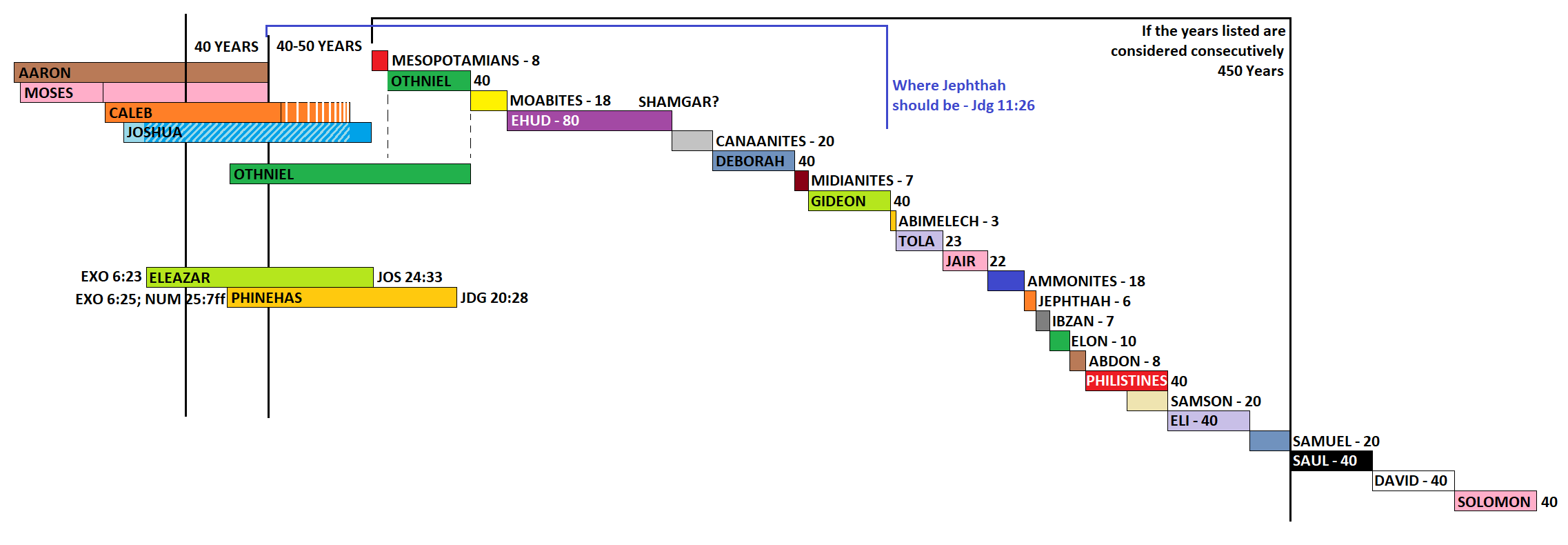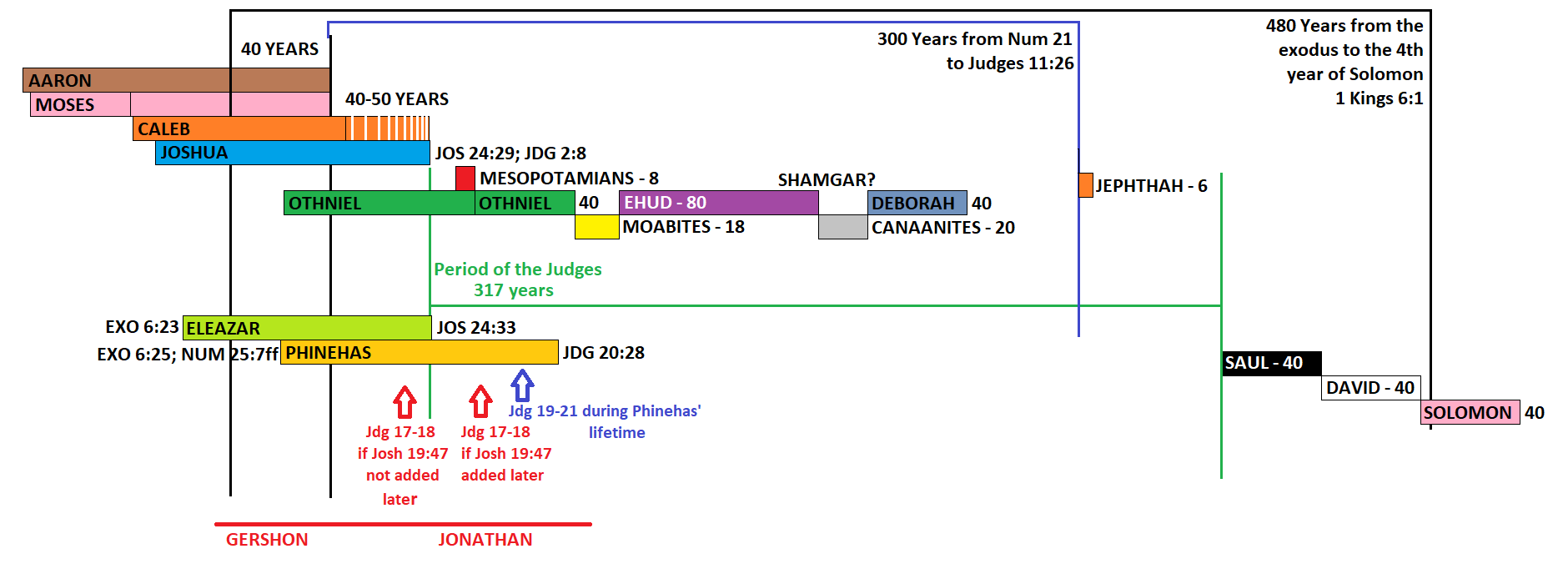OVERVIEW TIMELINE OF JUDGES
This is perhaps the hardest era in Israelite history to gauge time for. There are many things to consider. First, we do not know when Joshua was born, so we do not know how long his rule was. We can surmise from certain clues in Scripture that he was a young man when he first began serving Moses, and that he was over 20 when the exodus began. Given these clues, we can surmise that Joshua’s rule was about 40 to 50 years. Second, we do not know how long the Israelites remained faithful after Joshua died. Third, we do not know how long it took after the death of Joshua, or some of the judges, for the Israelites to fall into oppression.
Whatever the case, we have three key Scriptures that give us some clue as to the timing of some of these events. The first is Judges 11:26. Jephthah is giving a history lesson to the Ammonites, how for 300 years they have held this land. The land Jephthah is referring to is just east of the Jordan which was conquered in Numbers 21. This land bordered that of the Ammonites. It is likely Jephthah is offering a rounded figure rather than something exact, but it is still helpful. The second is in 1 Kings 6:1. This is the construction of the temple in the fourth year of Solomon’s reign. It is stated that it had been 480 years since the exodus. Doing some math, and assuming 80 years for the combined reigns of Saul and David, that leaves 357 years for the conquest and rule of Joshua through the period of the judges, and about 307 to 317 years after Joshua died.
Fig. 1 – Timeline showing where Judges 11:26 and 1 Kings 6:1 fall into place. We do not know when Caleb dies, but the black line in his timeline shows where he receives his inheritance in Joshua 14. Othniel is represented here, estimating he was 20 when he took Debir in Joshua 15 and Judges 1. Since he is also the first judge, we have some idea when he died, over 48 years after the death of Joshua. Eleazar, the son of Aaron, is here, and appears to die not long after Joshua in the narrative. Phinehas, his son, is also here. He is estimated to be 20 when he killed Zimri and Cozbi in Numbers 25. He appears in Judges 20:28 as a high priest. This will be addressed later, as will the length of the reigns of Saul, David, and Solomon.
The third verse is found in Acts 13:20. This seems to indicate that the period of the judges was about 450 years. There seems to be a discrepancy until one considers variant readings. In the manuscripts that more modern translations are based on, the word order is a little different, making the approximate time of 450 years apply to their stay in Egypt through the conquest of Canaan. However, if we add up all the periods of oppression and rest that are listed in Judges, it comes out to 450 years. This cannot be the same 450 years of Acts 13:20 for two reasons: 1) Paul says that it was about 450 years, not exactly, and 2) it seems clear that all the time periods mentioned in Judges are not meant to be taken consecutively.
Fig. 2 – Here is how we would have to look at it if we were to ignore 1 Kings 6:1 and go with this understanding of Acts 13:20.
Fig. 3 – When we input all the judges into the timeline consecutively, here is what we get. We see where Jephthah should be based on Judges 11:26, which is about 66 years earlier than taking them consecutively allows. Samson’s judgeship was known to take place during the 40 years of Philistine oppression, and there is no mention of a period of rest for him. Samuel’s judgeship of 20 years is taken from 1 Samuel 7:2, where it is assumed the ark of the covenant stayed at Kirjath Jearim for the length of time of his judgeship, though it was probably much longer based on 1 Samuel 8:1.
For the purposes of this exercise, we will need to make some assumptions. Let us first assume that the period of the judges was 317 years. Second, let us assume that Jephthah was precise when he said the Israelites have been in Gilead for 300 years. Third, we will give the Israelites about 10 years of peace after Joshua’s death before they were oppressed by the Mesopotamians. The qualifiers for the faithful elders who outlived Joshua were that they “had known all the works of the Lord which He had done for Israel” (Josh. 24:31). If we take the word “know” in the sense of having experienced, then they were under 20 when the exodus occurred and would have died not long after Joshua.
The Book of Judges is divided into three parts. We have covered the first, Judges 1-2 when we covered Joshua since much of that is a review of events that occurred in Joshua’s life. Judges 3-16 cover the individual judges themselves, from Othniel to Samson. But for the moment, we are going to consider the third part, Judges 17-21. This last part can be further divided up into two distinct events. The first I have called “Dan’s Migration” (Judges 17-18), and the second is “War with Benjamin” (Judges 19-21). We will also consider one more thing, the Book of Ruth, since it also takes place in the time of the judges (Ruth 1:1).
Dan’s Migration (Judges 17-18)
One of the major players in these events is a Levite who will not be named until the end of the story (Judges 18:30). He is Jonathan the son of Gershom, the son of Manasseh. We also know he was a young man from Bethlehem of Judah (Judges 17:7). Who is this Jonathan son of Gershom son of Manasseh? After looking at all the descendants of Manasseh, son of Joseph, I could find no Gershom. But the footnote I have for Manasseh was that other places say Moses. This is because it would appear an extra letter had been added as a superscript in some manuscripts in order to try keeping Moses’ name from being scandalized. So this Jonathan is Moses’ grandson. Since he is a young man, this places these events early in the time of the judges, perhaps in the time of Othniel.
There is a problem, however. After Jonathan joins the Danites on their migration north, they conquer an area called Laish, renaming it Dan. The problem comes with Joshua 19:47. That passage records the same thing, except concerning a town called Leshem, which is really the same place. There are three possibilities:
In order for it to be in Joshua, Joshua must have recorded it before his death. So perhaps it takes place in the time between the inheritances are assigned and Joshua’s death. The problem with this is that it is clear Micah in Ephraim (near Joshua) was idolatrous along with the Danites despite passages that indicate the people’s faithfulness until after Joshua died.
Perhaps it was added in later to help the reader understand why Dan is up north. This opens up a can of worms I’m not ready to open yet.
Perhaps it was an ongoing event in which the migration started before Joshua died, but continued through to Othniel’s time. The last of the Danites that were heading north were migrating when they spotted Jonathan serving as priest for Micah.
Not all of the Danites migrated north since Samson is a Danite and fought the Philistines down south.
War with Benjamin (Judges 19-21)
Here is the reason for considering the age of Phinehas in our timeline. Phinehas was serving as high priest after his father Eleazar died at the end of Joshua. He was already in his 60s by this time, assuming he was 20 when he killed Zimri and Cozbi (Num. 25). It is unlikely he lived more than 58 years later (10 years after Joshua + 8 years of Mesopotamian oppression + 40 years of Othniel as judge), so it seems likely that this, too, occurred during Othniel’s time as judge.
These events nearly destroyed the tribe of Benjamin, reducing them down to 600 men. Seven hundred of Benjamin’s soldiers, ironically enough, were all left-handed in the special forces (Judges 20:15-16). Ehud, the judge to follow Othniel and Moabite oppression, was a left-handed Benjamite. He was the hero of Israel several years after his tribe was demolished. Since his judgeship lasted 80 years, it is likely that he was not among the soldiers of Benjamin who fought against the rest of Israel, but one of their sons. Knowing how the 600 Benjamites obtained wives after they were demolished, we recognize an unpleasant reality.
Fig. 4 – Below is the timeline for Judges 17-21 including Dan’s Migration and the War with Benjamin. To help with timing Dan’s Migration, I have the lineage of Jonathan, grandson of Moses. Gershon was not too old when Moses went back to Egypt, and Jonathan was a young man in Judges 17-18. The War with Benjamin (Judges 19-21) had to be in the lifetime of Aaron’s grandson Phinehas (Judges 20:28). Included are the first three oppressions and judges.




I love the timelines. They give a really nice overview of where the judges fit compared to each other. Can I use one of them in a sermon?
Of course! Sorry this is so late from when you sent this. I’ve been rather busy, and am impressed these old timelines have been getting so much attention lately. If you’d like, I’ve been working on a daily chronological Bible reading based on these studies. Some opinions have changed since I put these lessons together, but not many. I could share it with you if you’re interested!
hello, I am writing a book on Biblical Chronology, the conclusion of Saul’s reign is similar to mine (10 years) the judgment of Samuel alone (after Elie’s death and before Saul’s coronation) I put 3 years, the my chronology differs from yours at other points. But Joseph I place in 1700 and the Exodus in 1446 with Pharaoh Tutmoses III. what is your contact for exchanging information?
This is actually something I’ve been working on continually, and often tweak things here or there. I currently place Joseph being sold as a slave in Egypt very near your date, in 1707 BC. All these early biblical dates are approximate, of course. I have been running through a chronological reading of Scripture in a Facebook group if you’d be interested in following it. We are currently in Solomon’s reign, but it shouldn’t be too hard to catch up. I’m using it to work out some of the bugs. If you have any input, please, feel free to voice it! You can contact me more directly here as well. https://www.facebook.com/profile.php?id=100088405179238
There is a serious problem with dating the Danite migration to Laish. The recent excavation of Tell Dan dated the Danite destruction of Laish to about 1150 BC – late in the period of the Judges. So Jonathan was a descendant (not literal son) of Gershom son of Moses. And the comment in Josh 19:47 dates to a later period than Joshua.
Hey, thanks for your comment! I’ll certainly have to consider that as I continue working on this. Where could I read and learn more about this?